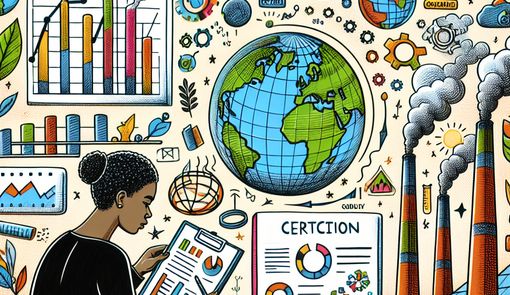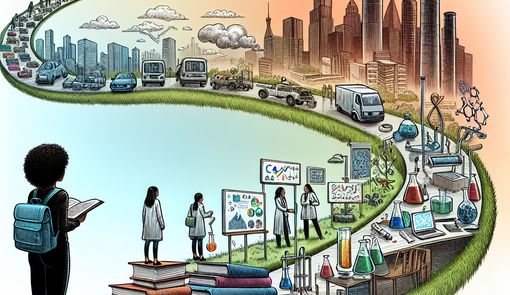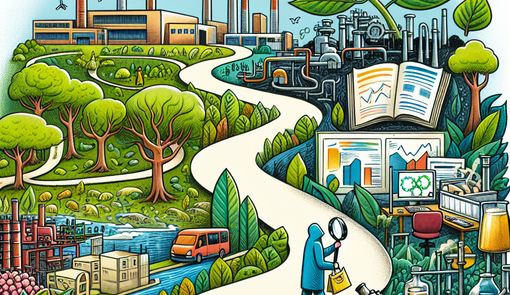Tech Tools and Software That Every Carbon Emissions Analyst Should Master

In the fight against climate change, carbon emissions analysts play a crucial role by examining emission sources, quantifying greenhouse gas (GHG) volumes, and advising on reduction strategies. As sustainability concerns gain traction, the demand for expertise in carbon accounting and management is on the rise. Analysts in this field require a robust set of technical tools and software to perform in-depth analysis and reporting. In this comprehensive guide, we will delve into the essential tech tools and software that every carbon emissions analyst should master to excel in this field.
Carbon Footprint Calculation Tools
GHG Protocol Tools - The cornerstone of carbon emissions analysis is the ability to calculate a carbon footprint accurately. GHG Protocol offers a range of calculation tools aligned with globally recognized standards for calculating and managing GHG emissions. These tools cover various sectors and provide methodologies for calculating emissions from specific activities or products.
Carbon Footprint Calculators - Various online calculators are available, each tailored for different organizational or project-level assessments. These allow analysts to quickly estimate emissions and explore what-if scenarios. Examples include the EPA's Greenhouse Gas Equivalencies Calculator and the Carbon Trust's Footprint Calculator.
Emissions Data Management and Reporting Software
Sustainability Reporting Platforms - Platforms like CDP (formerly Carbon Disclosure Project), GRI (Global Reporting Initiative), and Sustainalytics enable organizations to benchmark performance and manage disclosures. Mastery of such platforms ensures analysts can navigate reporting requirements efficiently.
Emissions Tracking Software - Specialized software for tracking emissions data, like Enviance, Enablon, or EMIS (Emissions Management Information System), can help analysts manage vast amounts of data, automate reporting processes, and ensure compliance with environmental regulations.
Climate Modeling and Analysis Tools
Integrated Assessment Models (IAMs) - Tools like MAGICC/SCENGEN and IMAGE allow analysts to explore future GHG emission trajectories and potential impacts. These models integrate a range of data and scenarios to assist in policy decision-making and long-term planning.
Geospatial Analysis Software - Understanding the geographic distribution of emissions is critical. Software such as ArcGIS or QGIS enables spatial analysis and mapping of emissions sources, aiding in the visualization and contextual analysis of GHG data.
Energy and Resource Management Systems
Enterprise Resource Planning (ERP) Systems - Systems like SAP and Oracle include environmental modules that allow for the extraction and analysis of operational data related to resource use and emissions. Proficiency in these systems is key for conducting large-scale corporate emissions assessments.
Renewable Energy Analysis Tools - RETScreen and HOMER are powerful tools for evaluating energy efficiency, renewable energy and cogeneration project potentials. These help analysts to advise on energy mix changes and identify opportunities for reducing carbon footprints through technology shifts.
Real-time Monitoring and IoT
Sensor Networks and IoT Solutions - The advent of the Internet of Things (IoT) allows for real-time monitoring of emissions. By mastering IoT platforms like Thingworx or IBM Watson IoT, analysts can analyze emission data as it's being generated and spot trends more quickly.
Remote Sensing and Satellite Imagery - Satellite data provides another dimension of real-time data, particularly useful for monitoring deforestation, urban sprawl, or other changes in land use that impact carbon emissions. Tools like Google Earth Engine can process this voluminous data for insightful analysis.
Data Analytics and Visualization Software
Statistical Analysis Software - Tools like R, Python with Pandas/NumPy, or SAS provide powerful capabilities for statistical analysis of emissions data. A solid understanding of programming and statistical modeling is increasingly important for sophisticated emissions analysis.
Data Visualization Tools - Communicating data effectively is as important as the analysis itself. Tools like Tableau or Power BI make complex data more accessible and actionable through interactive dashboards and visualizations.
Life Cycle Assessment (LCA) Software
LCA Software - Software like SimaPro, GaBi, or OpenLCA allows for comprehensive life cycle assessments, which are critical for evaluating the total environmental impact of products or services. Learning to conduct LCA helps analysts incorporate a broader spectrum of sustainability metrics.
Conclusion
Mastering these tools and software enables carbon emissions analysts to provide valuable insights and actionable recommendations for reducing carbon footprints. As the landscape of environmental regulations and corporate sustainability goals evolves, analysts equipped with these technical skills will be integral to advancing climate action and shaping a greener future.
The toolkit we've outlined provides a foundation for high-quality analysis, but it's important for analysts in this field to stay abreast of the latest technologies and updates. Continued learning and remaining flexible to integrate new tools as they become available will distinguish the top analysts and contribute significantly to their effectiveness in combating climate change.
Frequently Asked Questions
1. What are the key technical tools and software that every carbon emissions analyst should master?
Carbon emissions analysts should prioritize mastering tools such as GHG Protocol Tools, Carbon Footprint Calculators, Sustainability Reporting Platforms, Emissions Tracking Software, Integrated Assessment Models (IAMs), Geospatial Analysis Software, Enterprise Resource Planning (ERP) Systems, Renewable Energy Analysis Tools, Sensor Networks and IoT Solutions, Remote Sensing and Satellite Imagery tools, Statistical Analysis Software, Data Visualization Tools, and Life Cycle Assessment (LCA) Software. These tools cover a range of functions from calculating carbon footprints to visualizing data and conducting comprehensive life cycle assessments.
2. How can mastering these tools benefit carbon emissions analysts?
By mastering these tools, carbon emissions analysts can enhance their analytical capabilities, streamline data management and reporting processes, make informed decisions based on climate modeling and analysis, optimize energy and resource management strategies, monitor emissions in real-time, and communicate findings effectively through data visualization. These tools empower analysts to provide valuable insights, drive sustainable practices, and contribute effectively to carbon footprint reduction efforts.
3. Are there training resources available for learning these tools?
Yes, there are various training resources available for individuals looking to master these tools. Online courses, tutorials, webinars, and certification programs offered by organizations, software providers, and educational institutions can help analysts acquire the necessary skills and expertise. Additionally, some software vendors provide user guides, documentation, and support to assist analysts in utilizing their tools effectively.
4. How can analysts stay updated on the latest advancements in carbon emissions analysis tools?
To stay updated on the latest advancements, analysts can join professional networks, attend conferences, workshops, and seminars focused on sustainability and carbon emissions analysis. Following industry publications, subscribing to newsletters, and participating in online forums dedicated to environmental sustainability can also provide valuable insights into emerging tools and technologies. Collaboration with peers and engaging with industry experts can further facilitate knowledge-sharing and awareness of new developments in the field.
5. Which factors should analysts consider when selecting the right tools for their specific needs?
When selecting tools, analysts should consider factors such as compatibility with existing systems, scalability for future growth, user-friendliness, data security features, pricing, technical support availability, and the specific requirements of their organization or projects. Conducting a thorough assessment of tool functionalities, conducting trials or demos, and seeking feedback from other users can help in making informed decisions regarding tool selection for optimal performance and efficiency.
Further Resources
For those looking to further enhance their expertise in carbon emissions analysis and stay updated with the latest tools and developments, here is a curated list of resources:
Training Courses and Certifications
- GHG Management Institute: Offers comprehensive online courses on GHG accounting and management.
- Greenhouse Gas Protocol Courses: Provides training on using GHG Protocol tools and calculating carbon footprints.
- Sustainability Reporting Standards: GRI offers certification courses on sustainability reporting.
Industry Associations and Networks
- The Carbon Trust: A leading organization providing advice and certification for sustainable business and the move to a low-carbon economy.
- CDP (formerly Carbon Disclosure Project): Engage with a global platform for environmental disclosure, providing insights for investors, companies, and cities.
- WRI (World Resources Institute): Access research and resources on environmental challenges and solutions.
Research Papers and Publications
- Intergovernmental Panel on Climate Change (IPCC): Stay informed with reports and publications on climate science and policy.
- Journal of Environmental Management: Explore research articles on environmental management practices and strategies.
- Environmental Science & Technology: Access cutting-edge research on environmental science and technology.
Online Forums and Communities
- Reddit - Sustainability: Engage in discussions on sustainability, climate change, and environmental initiatives.
- LinkedIn Groups - Environmental Management: Connect with professionals in the environmental management field for insights and networking.
Webinars and Conferences
- GreenBiz Webcasts: Attend webinars on sustainable business practices, including emissions reduction strategies.
- Climate Week NYC: Participate in a global forum for climate action, showcasing events, discussions, and initiatives.
Additional Reading Materials
- “Drawdown” by Paul Hawken: Explore solutions to reverse global warming through practical approaches and innovative strategies.
- “The Sixth Extinction” by Elizabeth Kolbert: Delve into the impact of human activities on Earth's biodiversity and ecosystems.
- “The Uninhabitable Earth” by David Wallace-Wells: Reflect on the consequences of climate change and the urgency for action.
These resources offer a wealth of knowledge and networking opportunities for carbon emissions analysts looking to enhance their skills and stay informed in a rapidly evolving field.






